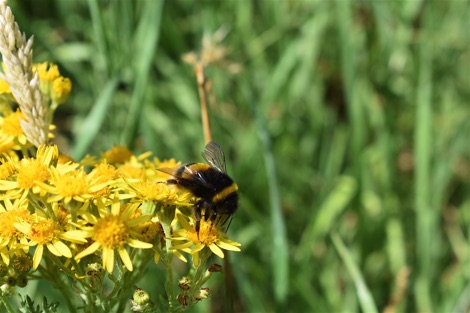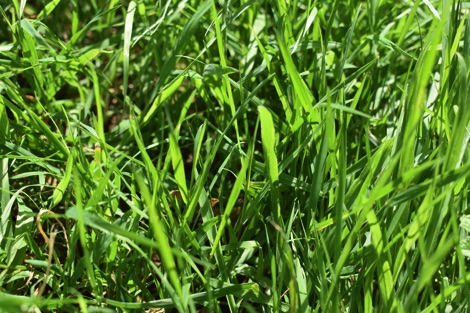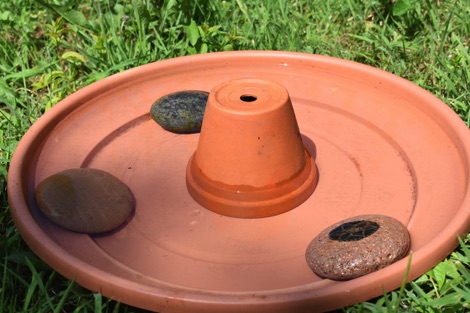
Helping wildlife
in hot weather
During periods of hot, dry weather, you can help mammals, birds and insects survive by providing water, shade and food
May 2025 was the second warmest May on record for England, with little rainfall and higher-than-average temperatures.
With heatwaves and more dry weather predicted this summer, now is the time to check how our gardens and green spaces are helping wildlife to survive during hot weather.
Heatwaves can have a devastating impact on nature. During prolonged periods of hot, dry weather, trees may drop their leaves prematurely to preserve water. Wild fruits and nuts, such as blackberries and hazelnuts, ripen early – causing shortages of food later in the year, when animals need to build up energy in preparation for winter and hibernation.
Wildlife can become ill with dehydration during heatwaves, and finding food can also be difficult. For example, blackbirds and other birds that forage for insects and worms in the soil can't access this source of food when the ground becomes baked during a heatwave.
Insects suffer in hot weather too. Butterfly caterpillars can die during heatwaves, and the plants that many insects feed on can be scorched in hot sunshine. Bumblebees overheat quickly in hot weather, and find it hard to fly to find the nectar-rich plants they need to survive.
Help in a heatwave
Offering water, food and shade are three easy things you can do to help wildlife this summer.


Providing water is essential so that mammals, birds and insects can drink. Animals also cool down in water – and it's particularly important for birds to have a place to bathe. This helps keep their feathers in tip-top condition, removing dirt and making it easier for them to preen.
A pond or water feature is ideal for helping wildlife – and they offer a habitat for frogs, toads and newts, as well as many invertebrates, such as dragonflies and damselflies. If you have a pond, make sure it's topped up – preferably with rainwater from a water butt, as this helps to maintain the correct ecological conditions for pondlife. But a little tap water is fine if that's all you have.
If you don't have a pond, one of two shallow containers of water can help all sorts of wildlife. A terracotta saucer is ideal, or you can use a washing-up bowl, upturned dustbin lid – or any water-tight container that's not too deep.

For any water feature, it's important to provide gently sloping entry and exit points. This allows easy access to the water, and prevents animals getting trapped and drowning. A few strategically placed stones can help, or use a short plank of wood to create a ramp.
Providing a few very shallow areas, by including some smaller pebbles or marbles, allows bees and bumblebees to access the water for a drink. Many natural sources are too deep or fast-flowing for bees and other insects, so this is a great way to help our struggling pollinators during hot weather. Bear in mind, though, that shallow water features like these may need topping up with fresh water every day.
Food for bumblebees
According to The Bumblebee Conservation Trust, 2024 was the worst year on record for the UK's bumblebees.
Because bumblebees struggle to forage in hot weather, providing plenty of easy-to-access, nectar-rich plants can really help them to survive.

Good choices are sedums, lavender, verbena, scabious, sunflowers, alliums, poppies, sweet peas and zinnias. Herbs such as rosemary, thyme and borage are also fantastic for bumblebees, as are fruit trees and bushes – apples, strawberries and blueberries for example.
It's important to grow plants with different-shaped flowers – this provides food for a range of bumblebee species. Simple, open flowers like apple blossoms are accessible to short-tongued bumblebee, while bumblebees with long tongues prefer tubular flowers like foxgloves. Avoid frilly, double flowers, which contain little nectar and pollen and are hard for insects to access.
If you have space, it's best to group the same plants together in clumps – this gives bumblebees a larger area to forage in without having to travel far from flower to flower, so saving energy.

If you spot a bumblebee on the ground, and it's been there for a long time, it may need an energy boost. You can help by gently moving the bee onto a nectar-rich flower – a dandelion is a good choice. When no flowers are available, and as a last resort, offer a white sugar and water 50/50 mix as a one-off energy boost. Don't feed them brown sugar or honey as these can make bumblebees ill.
Remember too that pesticides harm and kill all insects – including bumblebees, butterflies and other pollinators. Encouraging beneficial insects into the garden or allotment by planting to attract beneficial insects is a much better way to deal with unwanted creatures like aphids.
Provide shade
One of the easiest ways to create a shady place for animals to shelter is to leave a patch of grass to grow long. Bumblebees nest in long grass, and frogs, toads and newts use it as a cool, moist place to rest.
Very short grass tends to dry out more quickly in hot weather, whereas longer grass copes much better with drought conditions. Grass that's left to grow a bit longer tends to remain green, while short-mown areas end up looking parched and dry.

If you leave an area of grass to grow it shouldn't be long before you see all sorts of wildflowers appearing. Red and white clover, buttercups, dandelions, ox-eye daisies, teasels and forget-me-nots are some of the most common wildflowers found in long grass – and all these flowers are an excellent source of nectar for all kinds of insects.
Having an undisturbed corner – where nettles, thistles and other wild plants can grow – is also an easy and effective way to provide shade, shelter, and food plants for caterpillars. A wild corner like this is a good habitat for all sorts of creatures, including beetles, slow worms, hedgehogs and toads.
Natures Calendar
Enjoy spending time in nature? Your observations of how plants and animals are faring in your garden, allotment or local green space can help The Woodland Trust monitor how different species are affected by rising temperatures related to climate change. Nature's Calendar is an ongoing survey that contributes to biological records that date back to 1736. Visit Nature's Calendar to contribute.
Little Green Space July 2025
Ads/Affiliate links
Little Green Space is a non-profit project sharing solutions to the nature and climate crises, and offering inspiration for a greener lifestyle. If you like our content, please help keep us going with a small donation!

